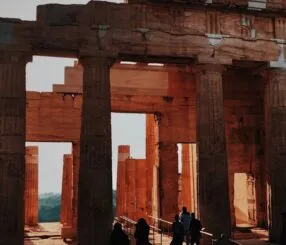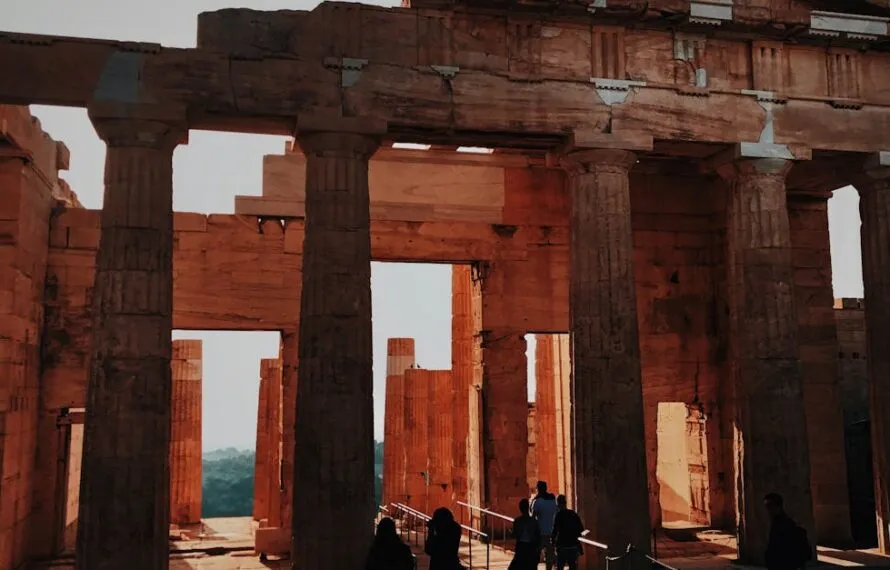The Parthenon in Athens stands as a testament to ancient Greek civilization.
Its grandeur and historical significance make it a must-visit for travelers.
However, when it comes to capturing its beauty through photography, visitors often wonder: Is photography allowed inside the Parthenon in Athens?
Understanding the rules and respecting the site’s cultural importance is crucial for any visitor.
O que este artigo aborda:
- Understanding the Parthenon’s photography policy
- Current regulations and restrictions
- Reasons behind photography limitations
- Historical significance of the Parthenon
- Overview of the Parthenon’s history
- Importance of preservation efforts
- Photography etiquette at historical sites
- General guidelines for visitors
- Respecting cultural and historical significance
- Alternative ways to capture the Parthenon’s beauty
- Recommended photography spots around the Acropolis
- Utilizing guided tours for better insights
- Legal implications of unauthorized photography
- Potential consequences for rule violations
- How to ensure compliance with local laws
- Visitor experiences and tips
- Personal accounts from tourists
- Advice for first-time visitors
- Resources for planning your visit
- Official websites and visitor centers
- Recommended reading and guides
Understanding the Parthenon’s photography policy
Current regulations and restrictions
When visiting the Parthenon, it’s important to know that photography inside the structure is generally restricted.
This rule aims to preserve the integrity of the ancient monument.
While you can take photos of the exterior and the surrounding Acropolis, capturing images inside the Parthenon itself is not permitted.
This regulation helps to protect the delicate architecture from potential damage caused by flash photography and overcrowding.
Reasons behind photography limitations
The restrictions on photography inside the Parthenon are not arbitrary.
They are in place to ensure the preservation of this iconic structure.
The Parthenon has withstood the test of time, but it remains vulnerable to the effects of modern technology.
Flash photography, for instance, can contribute to the deterioration of ancient materials.
Additionally, limiting photography helps manage the flow of visitors, preventing congestion and ensuring a more respectful experience for everyone.
Historical significance of the Parthenon
Overview of the Parthenon’s history
Constructed in the 5th century BC, the Parthenon served as a temple dedicated to the goddess Athena.
Its architectural brilliance and historical importance have made it a symbol of ancient Greece.
The Parthenon has witnessed centuries of history, from its days as a temple to its transformation into a Christian church and later a mosque.
Each phase of its existence adds layers to its rich history.
Importance of preservation efforts
Preserving the Parthenon is of utmost importance.
As a UNESCO World Heritage site, it represents not only Greek heritage but also a significant part of human history.
Conservation efforts aim to maintain its structural integrity and aesthetic beauty for future generations.
By adhering to photography restrictions, visitors contribute to these preservation efforts, ensuring that the Parthenon remains a source of inspiration and knowledge.
Photography etiquette at historical sites
General guidelines for visitors
When visiting historical sites like the Parthenon, it’s essential to follow certain etiquette.
Respect the site’s rules and regulations, including photography restrictions.
Avoid touching or leaning on ancient structures, as this can cause damage.
Be mindful of other visitors, allowing everyone to enjoy the site without disruption.
By practicing good etiquette, you contribute to the preservation of cultural heritage.
Respecting cultural and historical significance
Understanding the cultural and historical significance of the Parthenon enhances your visit.
Recognize that this site holds deep meaning for many people, both locally and globally.
Approach your visit with reverence, appreciating the stories and history embedded within its walls.
By respecting the site’s significance, you enrich your own experience and honor the legacy of those who came before.
Alternative ways to capture the Parthenon’s beauty
Recommended photography spots around the Acropolis
While photography inside the Parthenon is restricted, there are plenty of opportunities to capture its beauty from outside.
The Acropolis offers stunning vantage points for photography.
Consider visiting during sunrise or sunset for breathtaking views.
The golden light during these times enhances the Parthenon’s grandeur, providing a perfect backdrop for your photos.
Utilizing guided tours for better insights
Joining a guided tour can enhance your understanding of the Parthenon.
Knowledgeable guides provide valuable insights into its history and significance.
They can also recommend the best spots for photography around the Acropolis.
By participating in a tour, you gain a deeper appreciation for the site and capture its essence through informed photography.
Legal implications of unauthorized photography
Potential consequences for rule violations
Ignoring photography restrictions inside the Parthenon can lead to legal consequences.
Authorities enforce these rules to protect the site.
Violating them may result in fines or other penalties.
It’s crucial to respect the regulations and avoid any actions that could harm the monument or disrupt the experience for others.
How to ensure compliance with local laws
Before visiting the Parthenon, familiarize yourself with local laws and regulations.
Check official websites or consult visitor centers for up-to-date information.
By staying informed, you ensure compliance with the rules and contribute to the preservation of this historical treasure.
Respecting local laws not only protects the site but also enhances your overall experience.
Visitor experiences and tips
Personal accounts from tourists
Many visitors to the Parthenon share their experiences, highlighting the awe-inspiring beauty of the site.
Tourists often express a sense of wonder and appreciation for the ancient architecture.
By respecting the photography restrictions, they find alternative ways to capture memories, such as sketching or journaling their experiences.
Advice for first-time visitors
For first-time visitors, preparation is key.
Wear comfortable shoes, as the terrain can be uneven.
Bring water and sunscreen, especially during the summer months.
Plan your visit during off-peak hours to avoid crowds.
By following these tips, you ensure a more enjoyable and memorable experience at the Parthenon.
Resources for planning your visit
Official websites and visitor centers
To plan your visit to the Parthenon, consult official websites and visitor centers.
These resources provide valuable information on opening hours, ticket prices, and any temporary restrictions.
Staying informed ensures a smooth and enjoyable visit, allowing you to make the most of your time at this iconic site.
Recommended reading and guides
Enhance your visit by exploring recommended reading and guides on the Parthenon.
Books and articles offer insights into its history, architecture, and cultural significance.
By educating yourself beforehand, you gain a deeper understanding of the site, enriching your experience and appreciation for this ancient wonder.
In conclusion, while photography inside the Parthenon is restricted, there are numerous ways to appreciate and capture its beauty.
By respecting the rules and understanding the site’s significance, you contribute to its preservation and ensure a meaningful visit.
Plan ahead, stay informed, and embrace the opportunity to experience one of the world’s most iconic historical sites.





Sem comentários